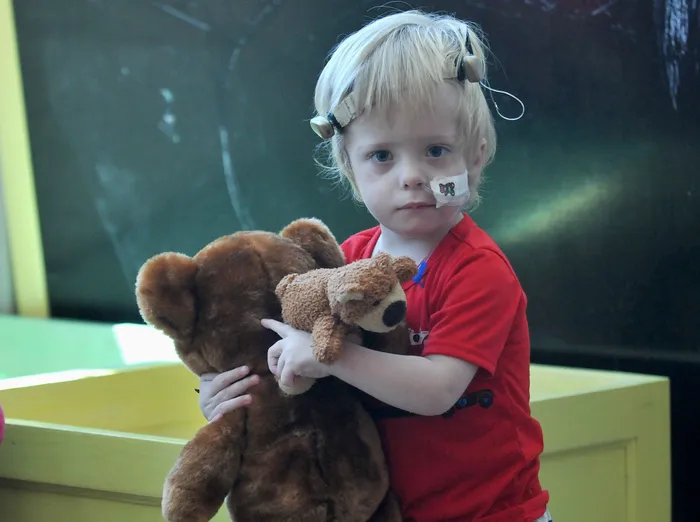
RESPIRATORY OPERATION: Evan Koch, 2, after his trachea surgery. Picture: Bheki Radebe/African News Agency/ANA RESPIRATORY OPERATION: Evan Koch, 2, after his trachea surgery. Picture: Bheki Radebe/African News Agency/ANA
Cape Town - Little Evan Koch, 2, is spending the new year a healthier person following a ground-breaking operation in a Cape Town hospital which saw his congenitally narrowed trachea (windpipe) widened - allowing him to breathe normally.
Evan, who travelled all the way from Windhoek in Namibia, is the first child to present with such a long (5cm) narrowed segment of the trachea in South Africa, making his case unique.
Born with a rare congenital condition known as tracheal stenosis (narrow trachea), the little boy not only struggled to breathe but his airway was so narrow that should he have fallen ill with a serious respiratory disease that caused inflammation, his windpipe would have closed off, resulting in sudden death. Doctors would also not have been able to insert the thin tube of a ventilator in him due to the size of the windpipe.
While it would have been impossible to treat his condition in South Africa a few years ago, thanks to a multidisciplinary team of doctors who performed the Slide Tracheoplasty on Evan at Chris Barnard Memorial Hospital, it is now possible to successfully treat other children with this condition in the private sector.
The team involves two paediatric airway surgeons, an ear, nose and throat (ENT) specialist, a cardiothoracic surgeon, a paediatric pulmonologist, an ICU specialist and a cardiac anaesthetist.
Chris Barnard Memorial Hospital was not only the first private hospital to perform the procedure in the country's private sector, it was the first time that doctors had operated on such a long segment of the tracheal stenosis.
While Slide Tracheoplasty - a procedure where doctors cut through the middle of the stenotic segment and sleeve (slide) the upper part into the lower part, doubling the diameter - is a standard practice overseas, it's relatively new in this country and can only be done by multidisciplinary centres with experienced surgeons.
So far the Red Cross Children's Hospital is the only public hospital that has been performing the procedure in the past two years. The hospital took the lead in this surgery following the return of Dr Shazia Pee, a paediatric ENT surgeon who also heads the Division of Paediatric Otolaryngology.
Peer, who has since established a special unit that specialises in this procedure, came up with the idea of using multidisciplinary teams after her two-year stint at the University of Toronto where she refined her craft as an ENT.
“It is life-saving surgery - it is very technical, mobilisation of vital structures is necessary, and the airway is interrupted during repair. Because the airway is critical to breathing, Evan needed to be put on cardiopulmonary bypass while we fixed his trachea,” said Peer.
An incision is made in the chest to open up the airway and the heart. Cardiopulmonary bypass (a heart-lung machine) may be used to allow oxygen and blood-flow to continue during the procedure.
During the surgery, the trachea is opened in the front and the back. It is then slid up on itself and reconnected to make the trachea shorter, but much wider. If the child has other vascular or heart abnormalities, the cardiothoracic surgeon may correct these as well.
Peer said Evan’s case was unique due to his long stenotic segment, approximately 5cm, and on the extreme end of what could be surgically correctable.
Dr Andre Brooks, a paediatric cardiothoracic surgeon who took part in the surgery, said that three years ago South African doctors would have struggled to perform the surgery due to a lack of skills for this complex procedure.
“Children with this condition would either have a tracheostomy (a surgical opening in the windpipe) or they would die. Nobody had the quality of expertise to do this kind of procedure before. The other option would be to seek treatment overseas.
"Performing this surgery on a child that was at the severe end of the spectrum gives us confidence that we can now perform it on many other kids with a similar condition,” he said.
Evan was incubated for 10 days and was in ICU for three weeks.
Dr Fiona Kritzinger, a paediatric pulmonologist and the primary specialist for Evan’s complete care, commended Evan’s parents for their courage in proceeding with the surgery. “It took a lot of bravery for the family to agree for us to perform such a complex surgery on their child,” she said.
After spending a month in hospital Evan had to learn to resume walking and talking as his muscle tone weakened during the ICU course. "His vocal cords were also affected post-surgery,” she said.
Evan’s parents, Dennis and Maritza Koch, said they were grateful for the outcome of the surgery.
“The condition had affected Evan’s life negatively. Not only did he breathe with difficulty, but he also struggled to eat because he had to focus on breathing while eating. He got tired easily and his development was also delayed due to his medical condition. We are looking forward to his recovery and his regaining his childhood,” said Dennis.
